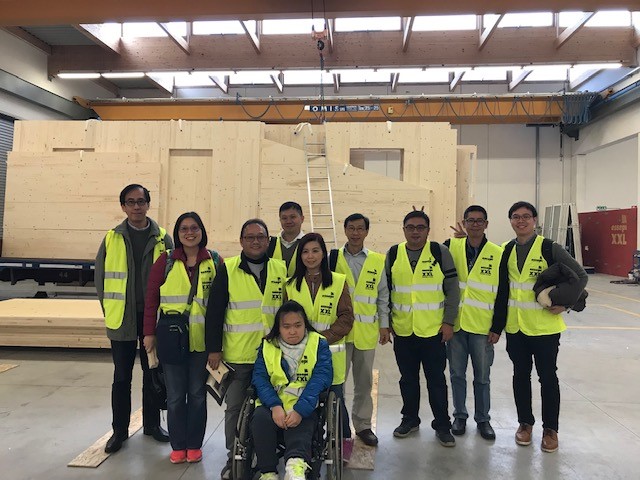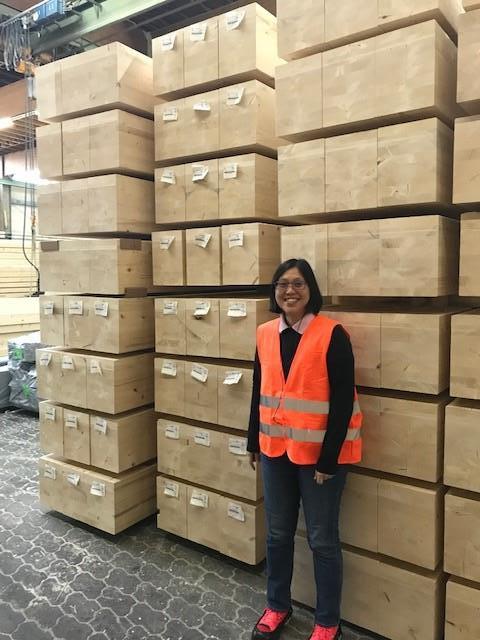Resembling a giant UFO hovering in mid-air, Eunoia Junior College’s (EJC) elevated track and field is truly one of a kind in Singapore.
Rising five storeys above ground, a part of the track is suspended over the scenic Kallang River, providing students with an amazing view during their runs.
But even more remarkable is the sheer number of facilities that lie beneath the track and field. Tucked under the sprawling structure are the school’s 900-seater auditorium, canteen, parade square and even an indoor sports hall.
This was all part of a plan to maximise space, as EJC sits on a 4-hectare site – roughly a third smaller than the typical plot size of other JCs.
“It was a small site, so everything had to be compacted,” said Er Joanne Ee. As the project’s Qualified Person, she took charge of the construction of Singapore’s first high-rise JC. “It means I’m the one signing the declaration to the authorities that the project was safe,” she said with a laugh.
She is one of three Professional Engineers to be conferred the BCA Design & Engineering Safety ‘Excellence’ Award (DESA) in 2021. It recognises engineers and teams for their innovative solutions and designs to overcome construction challenges.
“I feel honoured,” said Er Ee, who was then working at construction consultancy CPG Consultants. “Many interesting structures were being built in Singapore at the same time then, so this really meant a lot for us.”
While the award was an individual accolade, she emphasised that credit goes to her team. “Everyone put in a lot of effort to ensure that we completed the project to what we envisioned it to be,” added the Principal Engineer who is now at BCA’s Building Plan and Polices department.
CONSTRUCTION CREATIVITY
Fitting so many facilities on such a small plot of land required plenty of ingenuity.
For instance, to free up as much space beneath the elevated track and field, the team brought in colossal beams that reduced the number of columns needed to prop up the sports facility. Each beam spans up to 36m – almost 10m longer than an average beam.
Building such massive structures onsite would also increase safety risks and require much more manpower. To resolve this issue, they turned to precast technology.
“We tried to prefabricate as much of the elements as possible,” she explained. “It was also much safer for the workers because less falsework was required, and this freed up space to concurrently do more work on-site.”
|
|
 Joanne (second from left) conducted an inspection of an MET supplier, the Essepi Factory in Italy, with the architect and builder teams from Kimly-Lian Ho Lee Joint Venture. They were inspecting their manufacturing process and the CLT panels to be used for the Eunoia JC project. Joanne (second from left) conducted an inspection of an MET supplier, the Essepi Factory in Italy, with the architect and builder teams from Kimly-Lian Ho Lee Joint Venture. They were inspecting their manufacturing process and the CLT panels to be used for the Eunoia JC project.
|
|
|
|
 Joanne also went to the Hess GMBH Factory in Germany with the architect and builder teams from Kimly-Lian Ho Lee Joint Venture to inspect the Glulam beams that were being manufactured for the Eunoia JC project.
Joanne also went to the Hess GMBH Factory in Germany with the architect and builder teams from Kimly-Lian Ho Lee Joint Venture to inspect the Glulam beams that were being manufactured for the Eunoia JC project.
|
|
This is also part of a wider push for Singapore’s Built Environment sector to incorporate more prefabricated components during builds to enhance construction productivity.
The Design for Manufacturing and Assembly (DfMA) construction process, used for certain parts of EJC, sees structural components being manufactured off-site before being put together on-site.
Prefabricated components comprised 70 per cent of the S$100 million campus, increasing productivity by more than 55 per cent. For example, the use of DfMA reduced the construction period of the school’s two towering teaching blocks by around two months.
FIRST OF ITS KIND
EJC’s elevated track and field is not the school’s only distinctive engineering feature.
When constructing the floor panels of its teaching blocks, the CPG team also opted for a building material that had never been used in Singapore: a prefabricated hybrid timber-concrete slab system called CREE.
There were multiple benefits to using the novel material, including enhanced safety.
“As compared to using pre-cast concrete, it is lighter. This reduces the stresses on the building’s foundation,” she said.
Like LEGO bricks, the CREE system could be easily pieced together as well, with their ease of use enhancing productivity.
But it provided more than just practical advantages. Thanks to its use of timber, CREE also beautified EJC’s classrooms with a rustic look that gives students the feeling of being in a log cabin.
“It offers a warmer atmosphere, in comparison to the bare-walled classrooms that we typically have in schools,” she noted.
SUSTAINABLE BUILDING
The timber used in CREE was also not just any ordinary wood, but a special kind called Glued Laminated Timber.
It is a type of Mass Engineered Timber (MET) – another kind of DfMA technology. As a sustainable, durable product, MET significantly lowers a building’s carbon footprint as compared to solely using concrete, which is a significant carbon emitter.
In addition, the engineering team also creatively combined the use of CREE with another type of MET that made up the façade of each classroom: Cross Laminated Timber.
Besides reducing carbon emissions, this plank-sized wood also maximises the use of an entire tree trunk, ensuring that no part of the tree goes to waste.
While there were plenty of challenges in constructing EJC, it was all part of the job for Er Ee – to resolve issues and provide solutions.
“It was a fun project and I learnt a lot from it as well – it was an eye-opener,” she said, citing how using unfamiliar materials such as CREE was an exciting learning experience.
Want to see more ingenious engineering feats in Singapore? Find out more about DESA and its other award winners here.